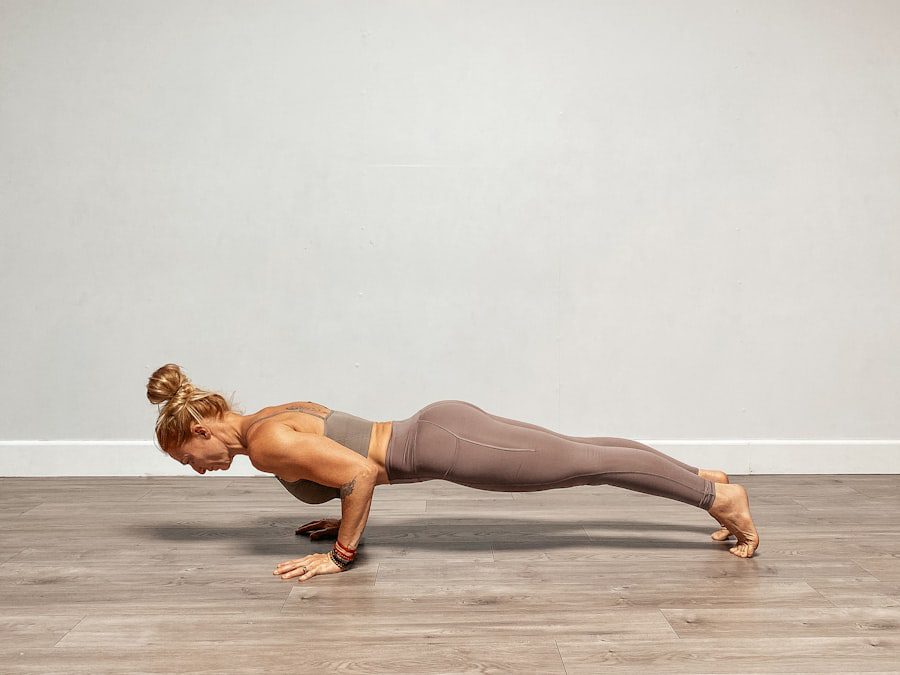Core strength is often heralded as the foundation of physical fitness, serving as a critical component in nearly every movement we perform. The core comprises a complex group of muscles, including the abdominals, obliques, lower back, and pelvic floor, all of which work in concert to stabilize the body. This stability is essential not only for athletic performance but also for everyday activities such as walking, sitting, and lifting.
A strong core enhances balance and coordination, allowing individuals to execute movements with greater efficiency and reduced risk of injury. Furthermore, a well-developed core can alleviate strain on the spine and improve posture, which is particularly beneficial in our increasingly sedentary lifestyles. Moreover, core strength plays a pivotal role in various sports and physical activities.
Athletes rely on a strong core to generate power and maintain control during dynamic movements. For instance, in sports like gymnastics or martial arts, the ability to twist, turn, and pivot effectively hinges on core stability. Beyond athleticism, core strength is integral to rehabilitation and injury prevention.
Individuals recovering from injuries often find that strengthening their core can lead to improved functional movement patterns and a decreased likelihood of re-injury. Thus, understanding the importance of core strength transcends mere aesthetics; it is about fostering a resilient body capable of performing optimally in both daily life and athletic endeavors.
Key Takeaways
- Core strength is important for overall stability, balance, and injury prevention
- Core strength training involves exercises that target the muscles in the abdomen, back, and pelvis
- Beginners can start with basic exercises like planks, bridges, and bird dogs to build core strength
- Athletes can incorporate advanced exercises like Russian twists, hanging leg raises, and medicine ball throws for a more intense core workout
- Incorporating core strength training into your workout routine can improve performance in other activities and reduce the risk of injury
The Basics of Core Strength Training
Understanding Core Strength Training
Core strength training is a comprehensive approach to enhancing the stability and endurance of the muscles that support the spine and pelvis. This type of training focuses on engaging multiple muscle groups simultaneously, promoting not only strength but also coordination and balance. The foundation of effective core training lies in understanding how to activate these muscles properly.
Activating the Core Muscles
Engaging the core involves more than just performing crunches; it requires a holistic approach that incorporates breathing techniques and mindful movement. By learning to activate the transverse abdominis, the deepest layer of abdominal muscles, individuals can create a solid base for all other movements. Incorporating a range of exercises into a core training regimen is essential for comprehensive development.
Progressing Core Training with Variety and Equipment
Traditional exercises like planks and bridges are excellent starting points, but they should be complemented with dynamic movements that challenge stability in various planes of motion. For instance, incorporating rotational exercises can enhance functional strength, mimicking the demands placed on the body during sports or daily activities. Additionally, utilizing equipment such as stability balls or resistance bands can further engage the core by introducing instability, forcing the muscles to work harder to maintain balance.
Achieving Optimal Results
Ultimately, understanding the basics of core strength training involves recognizing the importance of variety and progression in order to achieve optimal results. By incorporating a range of exercises and equipment into a core training regimen, individuals can develop a strong and stable core that enhances overall physical performance and reduces the risk of injury.
Top Core Strength Training Exercises for Beginners

For those new to core strength training, starting with foundational exercises is crucial for building confidence and ensuring proper form. One of the most effective beginner exercises is the plank, which engages multiple muscle groups while promoting stability. To perform a plank, one should position themselves face down on the floor, resting on their forearms and toes while keeping the body in a straight line from head to heels.
Holding this position for 20 to 30 seconds initially can help develop endurance in the core muscles. As strength improves, individuals can gradually increase the duration or explore variations such as side planks or plank jacks to further challenge their stability. Another excellent exercise for beginners is the dead bug, which emphasizes coordination and control while engaging the core.
To execute this movement, lie on your back with your arms extended toward the ceiling and your knees bent at a 90-degree angle. Slowly lower one arm and the opposite leg toward the floor while maintaining contact with your lower back against the ground. This exercise not only strengthens the core but also enhances awareness of body mechanics and promotes proper alignment.
Incorporating these foundational exercises into a regular routine can set beginners on a path toward developing a strong and resilient core.
Advanced Core Strength Training Exercises for Athletes
| Exercise | Description | Benefits |
|---|---|---|
| Plank | Hold a push-up position with your body straight | Improves core stability and endurance |
| Russian Twists | Sit on the floor, lean back, and twist from side to side | Targets obliques and improves rotational power |
| Leg Raises | Lie on your back and lift your legs towards the ceiling | Strengthens lower abdominal muscles |
| Dead Bug | Lie on your back and extend opposite arm and leg | Improves coordination and stability |
As individuals progress in their core strength training journey, they may seek more advanced exercises that challenge their stability and power output. One such exercise is the medicine ball slam, which combines explosive movement with core engagement. To perform this exercise, an athlete stands with feet shoulder-width apart while holding a medicine ball overhead.
With a swift motion, they slam the ball down to the ground while engaging their core and using their legs for added power. This dynamic movement not only strengthens the core but also enhances overall athletic performance by improving coordination and explosiveness. Another advanced exercise that athletes can incorporate into their training regimen is the hanging leg raise.
This exercise targets the lower abdominal muscles while also engaging the hip flexors and upper body for stabilization. To execute a hanging leg raise, an athlete must hang from a pull-up bar with an overhand grip and lift their legs toward their chest while keeping them straight. This movement requires significant core strength and control, making it an excellent addition for those looking to take their training to the next level.
By integrating these advanced exercises into their routines, athletes can develop a powerful core that supports their performance across various sports.
Incorporating Core Strength Training into Your Workout Routine
Integrating core strength training into an existing workout routine can be both straightforward and effective when approached thoughtfully. One strategy is to incorporate core exercises into warm-up sessions or cooldowns, ensuring that these critical muscles are engaged before or after more intense workouts. For example, performing planks or bird-dogs as part of a warm-up can activate the core muscles and prepare them for subsequent movements.
Alternatively, including core-focused exercises at the end of a workout can serve as an effective finisher that challenges endurance while promoting muscle fatigue. Another approach is to blend core training with other forms of exercise, such as resistance training or cardiovascular workouts. For instance, circuit training that alternates between strength exercises and core movements can maximize efficiency while providing a comprehensive workout experience.
This method not only keeps workouts engaging but also ensures that individuals are consistently challenging their core throughout various types of training sessions. By thoughtfully incorporating core strength training into their routines, individuals can reap the benefits of improved stability and performance across all aspects of fitness.
Common Mistakes to Avoid in Core Strength Training

Common Pitfalls in Core Strengthening
When embarking on a journey to strengthen the core, it is essential to be aware of common pitfalls that can hinder progress or lead to injury. One prevalent mistake is neglecting proper form during exercises. Many individuals may rush through movements or sacrifice technique for speed or intensity, which can diminish effectiveness and increase the risk of injury.
The Importance of Proper Form
For example, during planks or crunches, failing to maintain proper alignment can place undue stress on the lower back rather than effectively engaging the abdominal muscles. Prioritizing form over quantity is crucial for maximizing results and ensuring safety during workouts. This means taking the time to learn and practice proper technique, even if it means reducing the number of repetitions or sets.
A Balanced Approach to Core Training
Another common error is focusing solely on superficial abdominal exercises while neglecting other essential muscle groups within the core. While exercises like sit-ups may seem appealing for achieving visible abs, they do not provide comprehensive strength development across all areas of the core. It is vital to incorporate a variety of movements that target different muscle groups—such as rotational exercises for obliques or stability work for lower back muscles—to create a balanced approach to core training.
Effective Core Strengthening
By avoiding these mistakes and adopting a well-rounded strategy, individuals can enhance their core strength effectively while minimizing potential setbacks. A balanced approach to core training not only improves overall strength and stability but also reduces the risk of injury and promotes long-term progress.
The Benefits of Building Core Strength
The advantages of building core strength extend far beyond aesthetic appeal; they encompass functional benefits that enhance overall quality of life. A strong core contributes significantly to improved posture, which can alleviate discomfort associated with prolonged sitting or standing. By stabilizing the spine and pelvis, individuals are better equipped to maintain proper alignment throughout daily activities, reducing strain on surrounding muscles and joints.
This improvement in posture not only fosters physical well-being but also boosts confidence as individuals carry themselves with greater poise. Additionally, enhanced core strength translates into improved athletic performance across various sports and physical activities. A stable core allows for more efficient transfer of power between the upper and lower body during dynamic movements such as running, jumping, or throwing.
Athletes with well-developed cores often experience increased agility and balance, enabling them to navigate their respective sports with greater ease and effectiveness. Furthermore, building core strength plays a crucial role in injury prevention; by fortifying these essential muscles, individuals can reduce their risk of strains or injuries related to instability or improper mechanics during physical exertion. Ultimately, investing time in developing core strength yields profound benefits that resonate throughout all aspects of life—both on and off the field.
FAQs
What are the best strength training exercises for your core?
Some of the best strength training exercises for your core include planks, Russian twists, bicycle crunches, and deadlifts.
Why is core strength important?
Core strength is important because it helps with overall stability, balance, and posture. A strong core also supports the spine and can help prevent injuries.
How often should I do core strength training exercises?
It is recommended to do core strength training exercises 2-3 times per week, allowing for rest days in between to allow the muscles to recover.
Can core strength training help with back pain?
Yes, core strength training can help with back pain by providing support to the spine and improving overall posture and alignment.
Are there any core strength training exercises to avoid?
Some core strength training exercises, such as sit-ups and leg lifts, can put strain on the lower back and should be avoided if you have a history of back pain or injury. It’s best to consult with a fitness professional to determine the best exercises for your individual needs.
- Unveiling the Truth: Weightlifting for Women and Strength Building - November 4, 2024
- The Ultimate Guide to Weightlifting for Beginners - November 4, 2024
- Boost Your Mood and Ease Anxiety with Cardio Exercises - November 4, 2024




